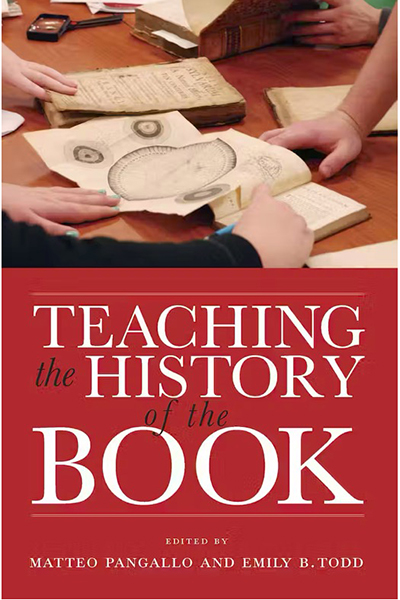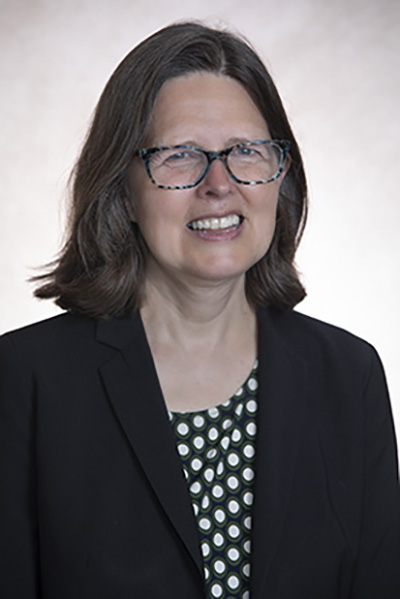- Apply
- Visit
- Request Info
- Give
Teaching a book’s history reveals another story
Emily Todd co-edits collection of essays
Written by Lucinda Weiss
Published on September 11, 2023
 Emily Todd, dean of the School of Arts and Sciences, has always been drawn to studying literature and history. She has combined the two interests in her new book, “Teaching the History of the Book,” a collection of 38 essays she co-edited with Matteo Pangallo, associate professor of English at Virginia Commonwealth University.
Emily Todd, dean of the School of Arts and Sciences, has always been drawn to studying literature and history. She has combined the two interests in her new book, “Teaching the History of the Book,” a collection of 38 essays she co-edited with Matteo Pangallo, associate professor of English at Virginia Commonwealth University.
Studying books as material objects — how they come into print and who is involved — touches on social history, literary culture and topics that can range far from the book’s content. “Teaching the History of the Book” is intended as a pedagogical resource for teachers of the relatively new, interdisciplinary field of book history.
“When I discovered it as a field, I was excited about it,” said Todd.
Whenever she has taught the novel “Charlotte Temple,” a bestseller in the late 1790s, she has brought to class an early edition of it that she found at the Whately (MA) Antiquarian Center. Students have examined the fragile pages, far removed from the digital text they usually encounter. The physical copy raises questions about how the novel was printed and disseminated from England to America and how it was received.
Todd’s own interest in early America was fostered at Amherst College, where she was an American Studies major. She studied with Robert Gross, now a professor emeritus at the University of Connecticut, who specializes in the social and cultural history of the United States. Later, as a Ph.D. student at the University of Minnesota, she was introduced to books such as “Revolution and the Word,” Cathy Davidson’s 1986 book about the rise of the novel in America.
As the daughter of a longtime editor at the “Atlantic Monthly” (and later Houghton Mifflin), Richard Todd, she grew up around editors and “listened to conversations as books were being made” and editors and writers discussed them. She has sometimes brought to class an 1862 edition of the “Atlantic Monthly,” spurring discussion among students. As contributors to her new book point out, novels that are now part of the literary canon sometimes got their start in serialized form in periodicals.

Conversely, Rachel Carson couldn’t get her warnings about pesticides into magazines because editors feared the wrath of advertisers, so she published them in the landmark book, “Silent Spring” in 1962, one of Todd’s book contributors wrote.
The history of the book as an interdisciplinary field of study took off in the 1980s and 1990s, and Todd wrote her dissertation on the subject. SHARP – the Society for the History of Authorship, Reading and Publishing – was established in 1992 and held its first international conference the next year.
When Todd first delved into the field in the mid 1990s, there were no digital resources about book history, so she spent a lot of times in archives. Now, more databases are available, showing images of old books and their illustrations. But digital representations cannot fully replace what you learn from a printed copy or an original work, she said.
“You might start asking different questions about it” when you examine the original, and archives might offer what else was published about that time.
What readers think about a book is always a question, and while Amazon reviews offer tips for contemporary readers, a historical examination can look more broadly at the culture at the time of the book’s publication, Todd said.
As she and Pangallo wrote in the new book’s introduction, book history encourages students to think about how media shapes meaning and how books are shaped by history. Book history is a good entree to scholarly research, said Todd.
“Book history lends itself to hands-on projects and research as students learn to consider the physical nature of texts,” she and Pangallo wrote.
She and Pangallo both taught book history courses early in their careers, and the experiences were formative for them as educators, they wrote. In Todd’s course, students had to construct their own book from a box of craft supplies she brought. She took them to a rare book room, and it was the first time any of them had handled old books.
“Our book history courses received enthusiastic responses from our students, not only because they featured this element of play, but because they introduced students to fresh ways of thinking about the most familiar object in their educational experience: the book,” wrote the editors.
It will be interesting to see how e-books, audiobooks, self-publishing and digital resources change reading practices, Todd said. Her new book was created during COVID and includes advice on teaching the history of the book online. As one essayist noted, new technologies are often resisted: Yale students rioted in 1837 when the blackboard was introduced.
Todd’s own favorite haunts for rare and historical books are the American Antiquarian Society in Worcester, MA, where she has done research, and The Library Company of Philadelphia, a research library founded by Benjamin Franklin, where she had a fellowship and spent a month studying in its rare book room.
“There were always things to discover,” she said.
“Teaching the History of the Book” was published by the University of Massachusetts Press.


